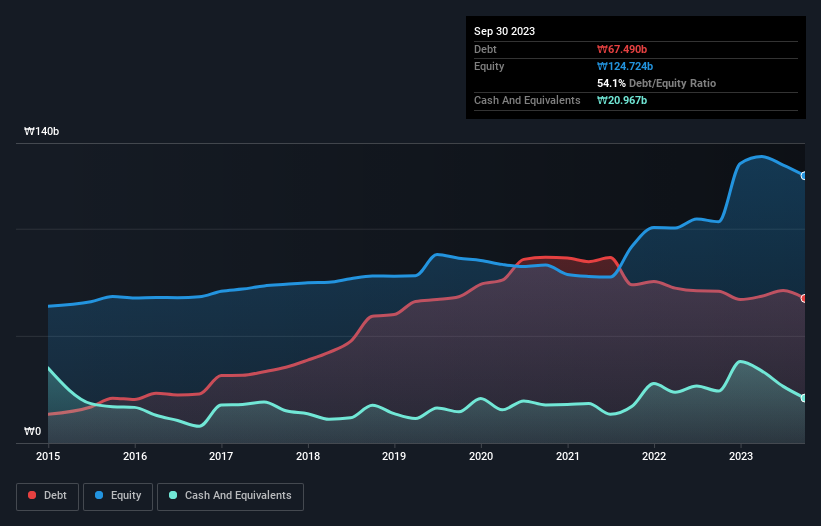- South Korea
- /
- Professional Services
- /
- KOSDAQ:A187220
Here's Why DT&C.Co.Ltd (KOSDAQ:187220) Can Afford Some Debt
Legendary fund manager Li Lu (who Charlie Munger backed) once said, 'The biggest investment risk is not the volatility of prices, but whether you will suffer a permanent loss of capital.' It's only natural to consider a company's balance sheet when you examine how risky it is, since debt is often involved when a business collapses. We can see that DT&C.Co.,Ltd (KOSDAQ:187220) does use debt in its business. But the more important question is: how much risk is that debt creating?
When Is Debt A Problem?
Debt and other liabilities become risky for a business when it cannot easily fulfill those obligations, either with free cash flow or by raising capital at an attractive price. If things get really bad, the lenders can take control of the business. However, a more usual (but still expensive) situation is where a company must dilute shareholders at a cheap share price simply to get debt under control. By replacing dilution, though, debt can be an extremely good tool for businesses that need capital to invest in growth at high rates of return. The first thing to do when considering how much debt a business uses is to look at its cash and debt together.
See our latest analysis for DT&C.Co.Ltd
What Is DT&C.Co.Ltd's Net Debt?
You can click the graphic below for the historical numbers, but it shows that DT&C.Co.Ltd had ₩67.5b of debt in September 2023, down from ₩70.8b, one year before. However, because it has a cash reserve of ₩21.0b, its net debt is less, at about ₩46.5b.

How Strong Is DT&C.Co.Ltd's Balance Sheet?
We can see from the most recent balance sheet that DT&C.Co.Ltd had liabilities of ₩65.0b falling due within a year, and liabilities of ₩33.4b due beyond that. Offsetting this, it had ₩21.0b in cash and ₩37.0b in receivables that were due within 12 months. So its liabilities outweigh the sum of its cash and (near-term) receivables by ₩40.4b.
This is a mountain of leverage relative to its market capitalization of ₩64.2b. Should its lenders demand that it shore up the balance sheet, shareholders would likely face severe dilution. When analysing debt levels, the balance sheet is the obvious place to start. But it is DT&C.Co.Ltd's earnings that will influence how the balance sheet holds up in the future. So if you're keen to discover more about its earnings, it might be worth checking out this graph of its long term earnings trend.
In the last year DT&C.Co.Ltd had a loss before interest and tax, and actually shrunk its revenue by 3.0%, to ₩107b. We would much prefer see growth.
Caveat Emptor
Importantly, DT&C.Co.Ltd had an earnings before interest and tax (EBIT) loss over the last year. To be specific the EBIT loss came in at ₩5.1b. Considering that alongside the liabilities mentioned above does not give us much confidence that company should be using so much debt. So we think its balance sheet is a little strained, though not beyond repair. Another cause for caution is that is bled ₩28b in negative free cash flow over the last twelve months. So in short it's a really risky stock. There's no doubt that we learn most about debt from the balance sheet. However, not all investment risk resides within the balance sheet - far from it. Case in point: We've spotted 3 warning signs for DT&C.Co.Ltd you should be aware of, and 1 of them is concerning.
If you're interested in investing in businesses that can grow profits without the burden of debt, then check out this free list of growing businesses that have net cash on the balance sheet.
New: Manage All Your Stock Portfolios in One Place
We've created the ultimate portfolio companion for stock investors, and it's free.
• Connect an unlimited number of Portfolios and see your total in one currency
• Be alerted to new Warning Signs or Risks via email or mobile
• Track the Fair Value of your stocks
Have feedback on this article? Concerned about the content? Get in touch with us directly. Alternatively, email editorial-team (at) simplywallst.com.
This article by Simply Wall St is general in nature. We provide commentary based on historical data and analyst forecasts only using an unbiased methodology and our articles are not intended to be financial advice. It does not constitute a recommendation to buy or sell any stock, and does not take account of your objectives, or your financial situation. We aim to bring you long-term focused analysis driven by fundamental data. Note that our analysis may not factor in the latest price-sensitive company announcements or qualitative material. Simply Wall St has no position in any stocks mentioned.
About KOSDAQ:A187220
Low risk and slightly overvalued.
Market Insights
Community Narratives



